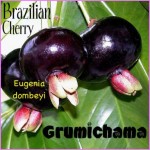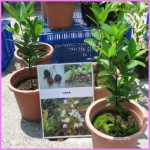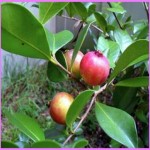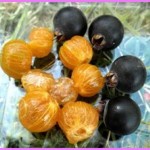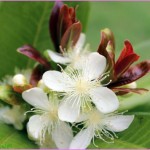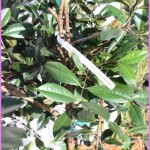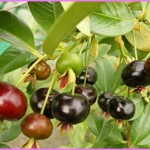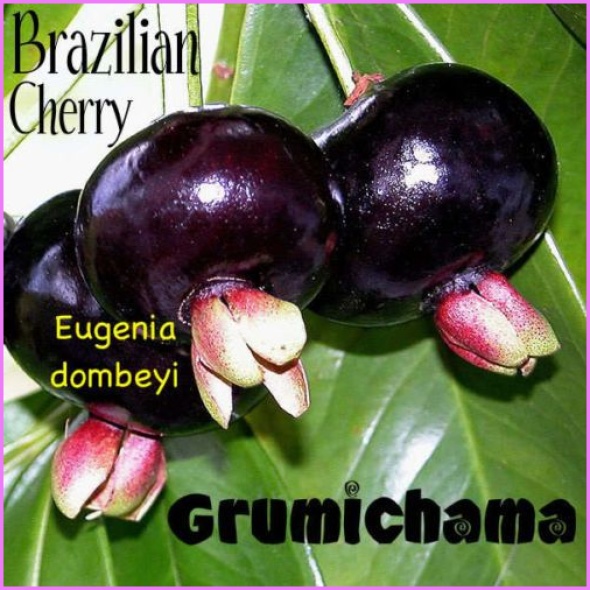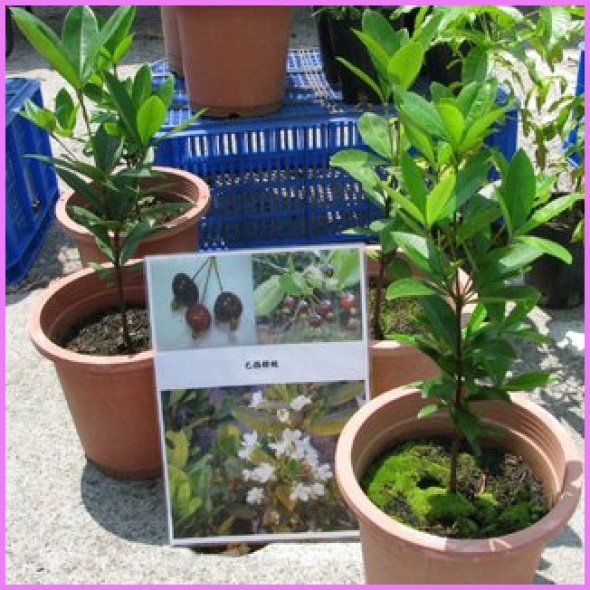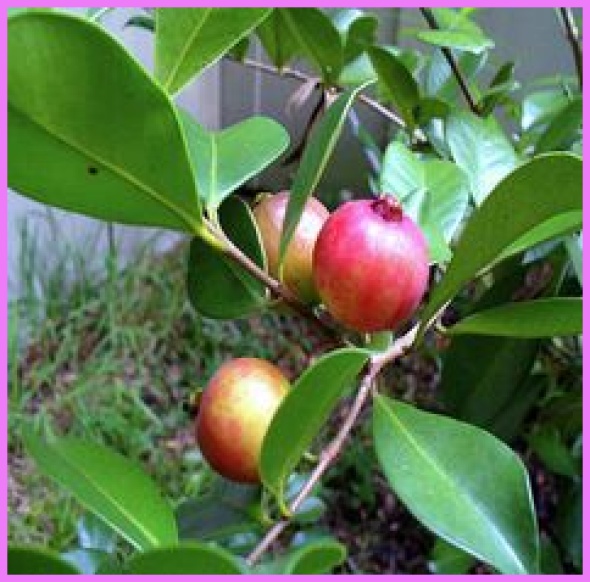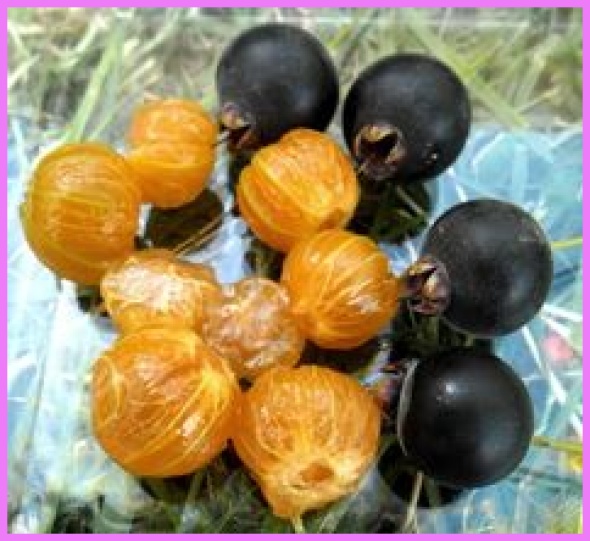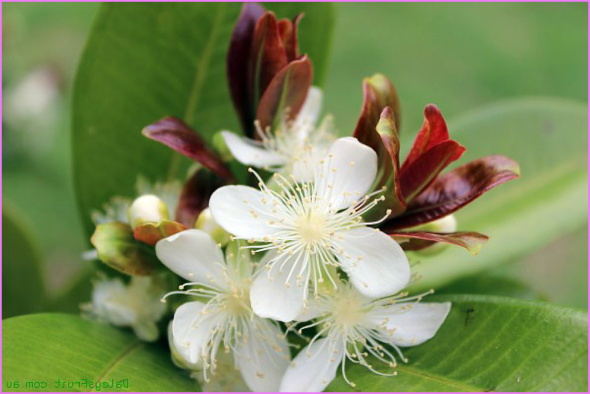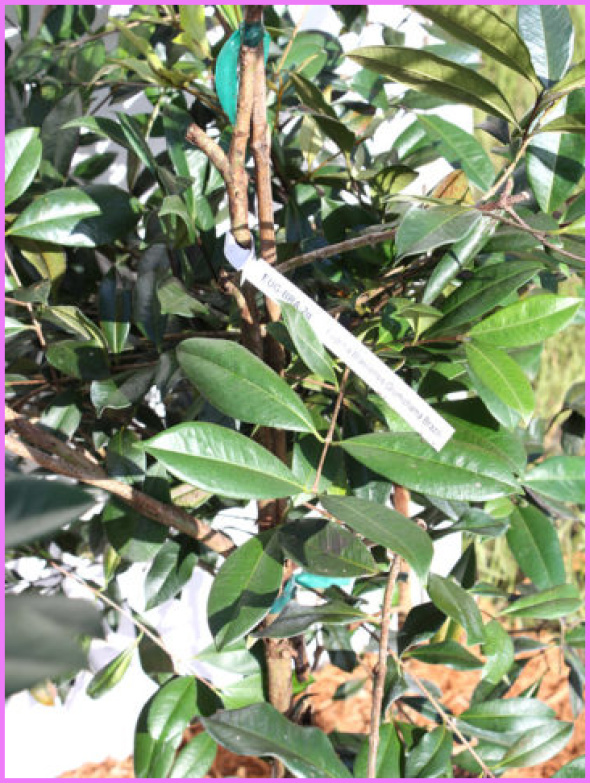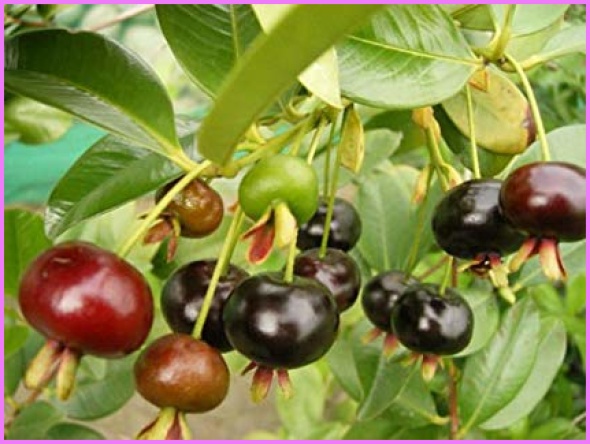Myrtaceae (Myrtle family) Description. Small, erect, evergreen tree, 6-13 m (20-43 ft) tall. Opposite, oval, leathery, glossy leaves 9-15 cm (3.5-6 in) long by 3-5 cm (1.2-2 in) wide. White flowers are produced in axils of leaves with 4 petals and about 80-120 stamens with yellow anthers. Dark red, dark purple, or yellow globose fruits measure 1.5-2.5 cm (0.6-1 in) in diameter with persistent calyx leaves at apex. Juicy, dark red or white, subacid to sweet pulp with 1-4 gray seeds and a cherrylike flavor.
Food uses. Ripe fruits are eaten out of hand or made into juices, jellies, and marmalade. Seeded fruits are sometimes added to fruit salads. A sauce made of boiled fruits and sugar is used for pie fillings and cakes.
Comments. Fruits are high in minerals like calcium and phosphorous. The wood is used in carpentry and turnery. The tree is also known by the synonym E. dombeyi.
Origin and Distribution. Native to southeastern lowlands of Brazil and parts of Uruguay and Paraguay. The Grumichama is occasionally cultivated in tropical and subtropical America, but rarely elsewhere. It prefers a subtropical climate and can withstand light frosts. With its showy white flowers, glossy leaves, and dark red fruits, the tree is often grown as an ornamental.
Description. Evergreen shrub or small tree, 4-6 m (13-20 ft) tall. Opposite leaves slightly pubescent, elliptic, 8-18 cm (3-7 in) long with prominent nerves. White, bee-pollinated flowers are produced singly or in small clusters of up to 4 flowers. Fruits are roundish, somewhat flattened, 5-10 cm (2-4 in) in diameter and 200-500 g (0.44-1.1 lbs) in weight, with up to 20 seeds. Ripe fruits have a thin, soft yellow skin with a creamy white, very juicy, subacid to acid, aromatic pulp. Fruits are easily bruised and must be handled with care.
Origin and Distribution. The araza is native to the western Amazon region of South America, where it grows in the understory of humid lowland rainforests. The tree was partially domesticated by indigenous tribes and is still cultivated mainly in its native habitat. It is also grown to some extent in Central America.
Food uses. The aromatic, acidic-sweet pulp of the araza is used to prepare fruit juices, ice cream, and jellies. The succulent flesh of the fruit is blended with ice, sugar, and water and sold in local markets as a refreshing drink. It can also be used as an exotic ingredient in desserts and cocktails and to make fruit wines and liquors.
Comments. The araza contains up to 100 mg (0.004 oz) ascorbic acid per 100 g (0.22 lbs) pulp and is therefore an excellent source of vitamin C. Its high pulp content (up to 90%) makes the fruit ideal for industrial production of frozen pulp.
This delicious fruit is still relatively unknown to consumers and surely underestimated, and it deserves much more attention. It was only in the 1930s that this member of the Myrtle family became known to the scientific world after being collected by G. Klug in the Amazon rainforest close to Iquitos, Peru.
Description. Evergreen shrub or small tree, 5-7 m (16-23 ft) tall. Glossy leaves alternate, dark green with obovate to lanceolate blades 4-6 cm (1.6-2.4 in) long. Emerging leaves are bronze-colored. Flowers cream-white, about 1 cm in diameter with 4 recurved petals and 50-60 long white stamens. Fruits 2-4 cm (0.8-1.6 in) in diameter, oblate, with 6-8 prominent ridges. As they ripe, they change from green (with yellow background) to bright red, scarlet, or almost black. Pulp juicy with a subacid to sweet and sometimes slightly bitter or resinous taste.
Origin and Distribution. Native to eastern South America from Surinam and Guyana to southern Brazil, Uruguay, and Paraguay. Although today the Surinam cherry is grown on a small scale in many tropical and some subtropical countries, it is cultivated predominantly in tropical America.
Food uses. Suriman cherries, a good source of vitamin C, are most often eaten out of hand or as a dessert after sprinkling with sugar. To remove any resinous taste, it is advisable to chill the fruits for several hours before serving. The fruits are used in fruit salads or as a topping for cakes and ice cream as well as pie fillings and also made into dessert sauces. A refreshing juice can be made from ripe fruits. They are also used to make jams and jellies and sometimes preserved in syrup or alcohol. In Brazil, the juice is fermented to produce vinegar or wine. In Southeast Asia, underripe fruits are pickled or made into chutneys. Comments. The Suriman cherry is grown as an ornamental or hedge plant in many regions of the world and has often been naturalized. In Bermuda, where it has grown out of control, it is considered invasive. The genus Eugenia consists of more than 1,000 species distributed in the tropics and subtropics. Description. Small, evergreen, shrubby tree growing 6-15 m (20-50 ft) in height. Opposite oval leaves with glossy green blades that produce a spicy smell when crushed. Flowers white with numerous white stamens. Fruits spherical to oblate, 8-12 cm (3-5 in) in diameter, soft to the touch with thin, pubescent orange-yellow skin. Pulp light orange, very juicy, acid to subacid and very fragrant.
Origin and Distribution. The uvalha is native to southern Brazil, where it occurs wild and in cultivation between 300 and 1,500 m (1,000-5,000 ft). It is virtually unknown outside its natural distribution. The tree, which is grown for its fruits and as an ornamental, requires a tropical to subtropical climate.
Food uses. The aromatic fruit is popular for making refreshing fruit drinks. The strained pulp is simply mixed with ice and sugar and served chilled. Uvalhas are sometimes made into jams and marmalade and used to flavor homemade ice cream and cake fillings.
Comments. The plant is also known by the synonym E. pyriformis var. uvalha. The genus Eugenia is a predominantly Neotropical genus with more than 1,000 species.
Benefits Of: GRUMICHAMA BRAZILIAN CHERRY Photo Gallery
Maybe You Like Them Too
- 5 Korean Hair Care Products To Try
- How to Remove Black Hair Dye and Restore Your Color
- Refusing To Camouflage Gray Hair At Work Reddit
- How To Stop Shampooing And Washing Hair Every Day
- How To Get Rid Of Oily Hair

